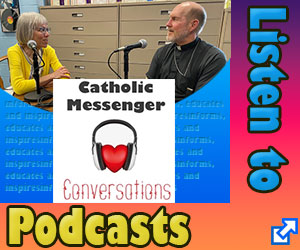By Barb Arland-Fye
My son Patrick, who just finished studying about the Cold War in his freshman high school social studies class, wanted to educate me about bomb shelters and the dangers of nuclear weapons.
He didn’t know that years ago my Catholic elementary school posted a placard indicating it had a safe place where we could go in the event of a nuclear bomb attack. We never had to use it, and I don’t even remember any emergency drills. I do remember a sense of fear about the possibility of the Soviet Union annihilating the U.S. with nuclear warheads. The Bay of Pigs was a few years behind us, but the threat of nuclear war had not subsided.
And I was haunted by documentary film images of Japanese children and adults who had been horribly disfigured or sickened as a result of exposure to radiation when the United States dropped the atomic bomb on Hiroshima, Aug. 6, 1945, and then on Nagasaki, Aug. 9, 1945.
Fast-forward to 2010 and the threat of a nuclear bomb attack remains a danger with catastrophic consequences. But signs of hope do exist.
“Practical steps such as the renewed START (Strategic Arms Reduction Treaty) between the United States and Russia can and are being taken,” said Laura Anderson, coordinator of the Clinton Franciscan Center for Active Nonviolence and Peacemaking.
“The recently completed Nuclear Security Summit, which focused on securing radioactive materials and keeping ‘loose nukes’ out of the hands of terrorists, is another example of global cooperation for global security without nuclear weapons.”
And the Clinton Franciscans have been sowing the seeds of a grassroots movement to seek the elimination of nuclear weapons. On May 2, from 1-4 p.m. they’ll host a symposium titled “Getting to Zero: Global Security without Nuclear Weapons” at The Canticle, 841 13th Ave. N., Clinton. All are invited.
Keynote speakers are Dr. Maureen McCue, a physician and adjunct professor of global health at the University of Iowa, and Ken Butigan, a peace and justice worker, teacher, writer and director of Pace e Bene Service in Nonviolence.
Dr. McCue will “discuss the history of nuclear weapons and the ongoing threat of a nuclear disaster and the cost of nuclear weapons,” according to a symposium flyer. Butigan “will explain why nuclear weapons are both ineffective and morally reprehensible and why Americans need to join with the world community in working to achieve nuclear disarmament,” the flyer states.
Anderson will lead discussion of a new Stanley Foundation film, “Radioactive Challenge,” which examines the need to secure nuclear materials so that they don’t fall into the wrong hands. A panel discussion on actions ordinary citizens can take to help bring about nuclear disarmament will conclude the symposium.
The symposium leads up to the Nuclear Non-Proliferation Treaty Review Conference, an international event that occurs every five years and will be held this year from May 3-28 at the United Nations in New York. The conference allows decision-makers representing 189 countries around the world to examine action on global nuclear policy.
Five years ago, the year of the last conference, the world also observed the 60th anniversary of the bombings of Hiroshima and Nagasaki. That anniversary inspired the Clinton Franciscans to take a corporate stand against nuclear proliferation, said communications director Sallyann McCarthy.
“It’s the greatest danger to all of humanity; there’s nothing to be gained from nuclear weapons,” she said. “The U.S. is the only country that ever used a nuclear weapon. We have a moral imperative to lead the cause of nuclear disarmament.”








